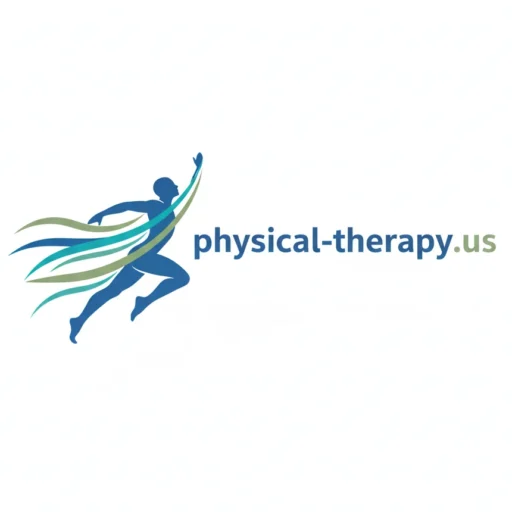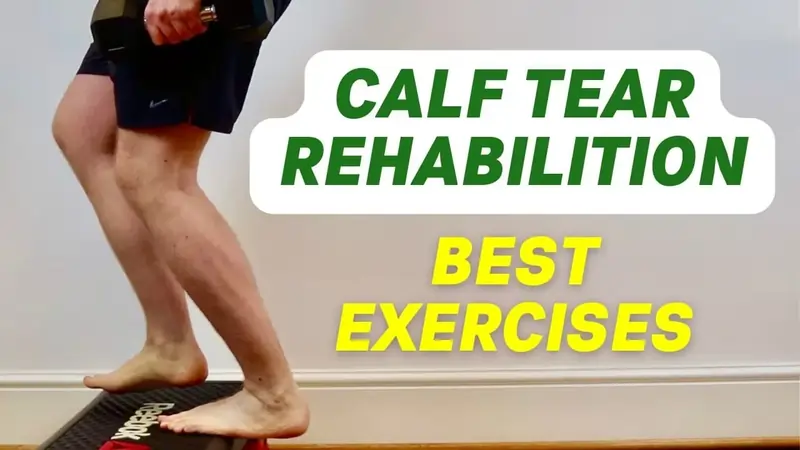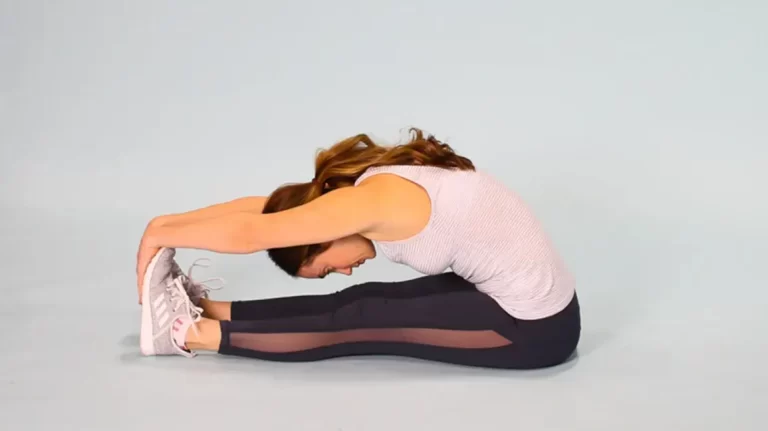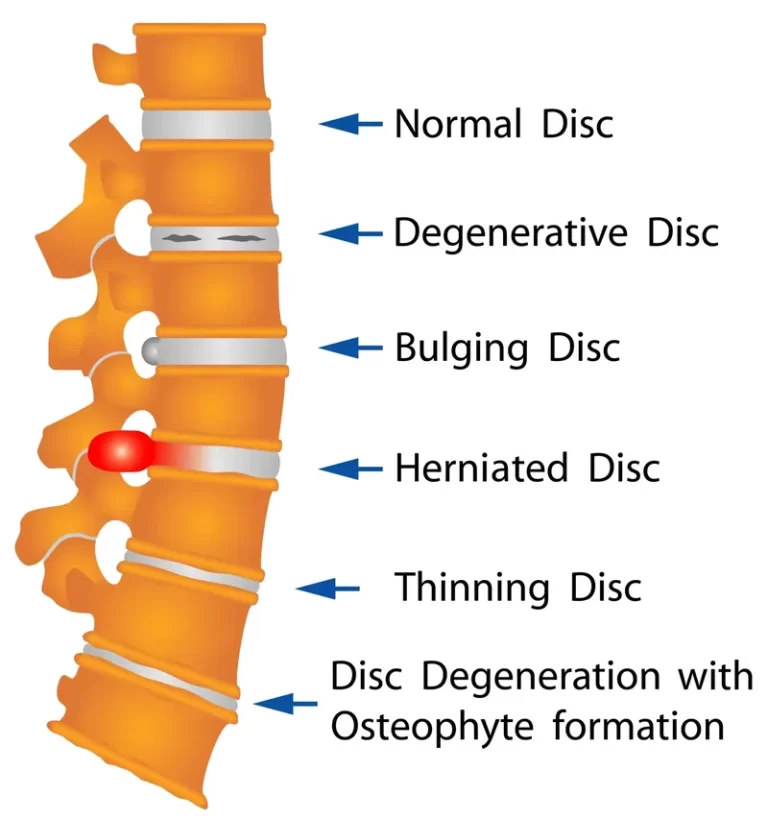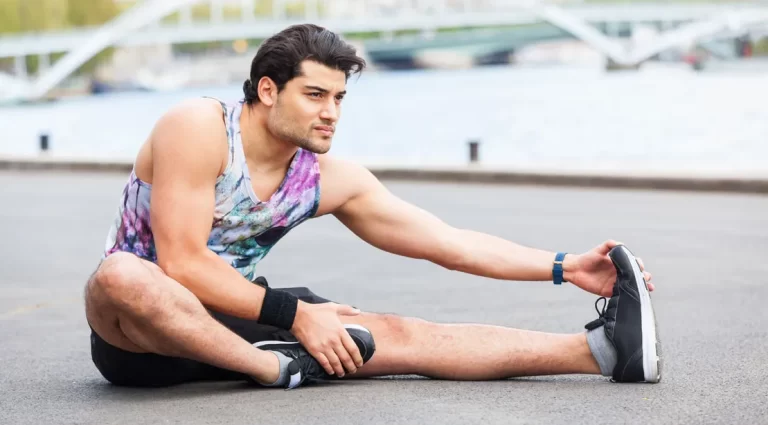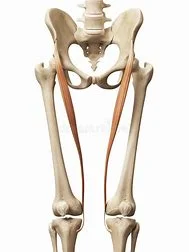13 Best Exercises For Calf Muscle Tear
Introduction:
When an excessive amount of stress is applied to a muscle or tendon, the result is an injury known as a strained or torn calf muscle. A calf strain (injury to tissue) or even partial or whole tearing of the muscle or tendon may happen from this. Usually occurring suddenly, calf muscle strains can be caused by recurrent loads over an extended period.
Calf strains are a common injury in sports. Regardless of age or level of athletic ability, anyone may get a calf strain. They frequently come on by rapid motions, such as running or jumping, and can be very painful.
There are 3 types of grades in calf muscle tears;
- Grade I (Mild): Minimal pain and minimal muscle fibre damage
- Grade II (Moderate): More ripped fibers; observable pain, edema, and restricted movement
- Grade III (extreme): Significant oedema, complete tear, reduced function, and severe pain
Recuperation may take weeks or months, based on how severe the injury is. However, with the correct rehabilitation Exercises For Calf Muscle Tears, healing can be much quicker, and additional injuries can be avoided.
Causes:
Degeneration of Muscles with Age
- As people age, their muscle flexibility and recovery decline.
Sudden Speeding Up or Sprinting
- The primary reason, particularly in sports like track, basketball, tennis, and soccer.
- The danger of tearing increases when there are sudden shifts in direction or speed because the calf contracts violently.
Muscle Fatigue
- Overworked muscles become weaker and less flexible.
- Particularly near the end of intense workouts, fatigued calf muscles are more prone to tension.
Biomechanical Abnormalities
- Uneven calves can be caused by overpronation, flat feet, or differences in leg length.
- A muscle experiences stress when it is under load or is positioned improperly.
Previous trauma or scar tissue
- Muscle that has scar tissue from a previous strain may be less flexible and more likely to rupture again.
- One significant risk factor is an early return to activity or improper rehabilitation.
Insufficient Warm-Up and Poor Flexibility
- Muscles that are not flexible can’t withstand sudden stresses as well.
- The risk of injury increases when there is no warm-up because it decreases blood flow and muscle flexibility.
Stretching the Muscle Too Much
- It takes place during motions like lunging or jumping.
- It’s particularly dangerous when muscles are cold or improperly warmed up.
Ineffective Method or Training Mistakes
- The uneven strain on the calf is caused by poor running or jumping technique.
- Training length, intensity, or location variations can all be suddenly raised.
Unsuitable Footwear
- Gait and muscular function can be impacted by footwear that doesn’t provide enough arch support or cushioning.
- High heels increase the risk of strain during every day activities by shortening the calf muscle and Achilles tendon.
Signs and symptoms:
Sudden, Sharp Pain
- Frequently experienced while performing activities at the rear of the lower leg.
- The sensation is described as “pulling,” “tearing,” or “snapping.”
- It may happen when you’re sprinting, jumping, or making rapid motions.
Bruising
- Internal bleeding from the tear may cause bruises (discoloration) to show up in a matter of hours or days.
Weakness in Muscles
- Not being able to push off the foot or stand on tiptoes.
- Walking or carrying weight difficulties.
Increased swelling
- It could show up right away after an accident, or it might take a few hours to show up.
- Restricted to the area surrounding the tear or more widely distributed throughout the lower leg.
Rigidity or Tightness
- After an injury, this is a common symptom, particularly in the morning or after sitting.
- Either because of inflammation, partial spasm, or muscular guarding.
- It may limit one’s capacity for ankle dorsiflexion or foot elevation.
Sensitivity
- Pain while applying pressure or contact to the calf’s affected area.
Popping Sound or Sensation
- More frequently observed in higher-grade tears, some people say they heard or felt a “pop” when they were hurt.
Exercise’s advantages:
Following a calf muscle injury, there are several advantages to doing the right workouts at the right timing and intensity. These activities are essential for a full recovery and are a basic part of therapy.
Encourages the Repair and Healing of Tissue
- Blood flow to the affected area is improved by mild, gradual activities.
- Healing muscle fibers receive oxygen and nutrients more effectively.
- Lessens the formation of scar tissue and encourages better tissue healing.
Over Time, Pain and Swelling Are Reduced
- The clearance of extra fluid is made easier by movement, which encourages lymphatic drainage.
- Reduced levels of inflammatory substances in the region, which relieves pain.
Develops Range of Motion and Flexibility
- Stretching exercises help to relieve tension and restore the normal length of muscles.
- Keeps joints from becoming tight and constricted, especially the ankle.
- Improves calf-related and surrounding muscle coordination.
Avoids Re-Injury
- Exercises for balance and strength improve proprioception, or the sense of joint position, and muscle coordination.
- These are essential for lowering the chance of tears in the future, particularly in athletes.
Improves Stability and Balance
- The calf muscles have a crucial stabilizing role during standing, jogging, and walking.
- Single-leg balancing and dynamic movement exercises that restore stability are frequent components of rehabilitation.
Strengthening and restoring muscle function
- Prevents the atrophy (muscle wasting) caused by a lack of activity
- Power and endurance are restored through the gradual strengthening of the soleus and gastrocnemius muscles.
- The ability to run, leap, walk, or stand on tiptoes is restored.
Prepare to Resume Sports or Other Activities
- Reduces a gap in recovery performance.
- Increases self-confidence and mental fitness for jobs or sports.
Exercises For Calf Muscle Tear:
Ankle pump
- Lying down allows you to extend your legs.
- Ensure that your feet are relaxed.
- Make sure your toes are pointed directly ahead.
- Pull your toes forward towards your shin while keeping your foot extended upward.
- This should help your lower leg’s front muscles get more flexible.
- Be slow and careful when you move.
- Then return to your neutral position.
- Then relax.
- Repeat these exercises five to ten times.
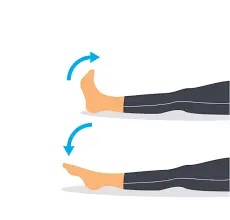
Ankle circle
- Put yourself in a chair first.
- Lift the affected foot.
- Only rotate your ankle while maintaining a straight leg.
- Rotate your foot carefully.
- Gentle clockwise direction.
- Once ten to fifteen rings have been completed, rotate anticlockwise.
- Then return to your neutral position.
- Then relax.
- Repeat these exercises five to ten times.
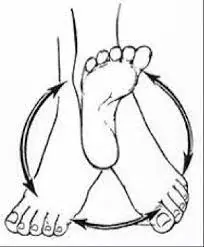
Standing calf stretch
- Stand firmly on the floor to start.
- As far back as it seems comfortable, place your hands on the wall.
- You have flat heels along with slightly bent knees.
- Hold this position for a few seconds.
- It should feel like your rear leg is stretched.
- Then return to your neutral position.
- Then relax.
- Repeat these exercises five to ten times.
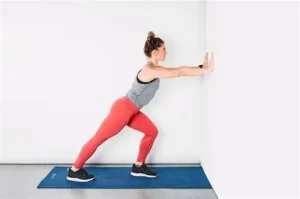
Seated Calf Stretch
- Start with the seating position.
- Then, without bending your knee, spread your leg out.
- Holding it in both hands, tightly anchor a resistance band around the sole of your foot.
- Exhale gently, then slowly draw the band in your direction while pointing your toes at yourself.
- This should cause your calf to stretch.
- You can increase the intensity of the stretch by pushing your heel away from you.
- Keep pulling the band until the stretch reaches its point of tension.
- Hold this position for a few seconds.
- Then return to your neutral position.
- Then relax.
- Repeat these exercises five to ten times.
- Do the same with the other leg.
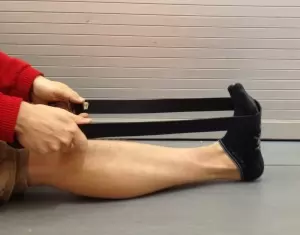
Resistance Band Plantarflexion
- Sit down on the floor.
- Next, extend your affected leg.
- Your foot’s heel has to have a resistance band looped around it.
- Apply pressure using your hands to both ends of the band.
- As you press against the band’s resistance, gently point your toes forward.
- Hold this position for a few seconds.
- Then return to your neutral position.
- Then relax.
- Repeat these exercises five to ten times.
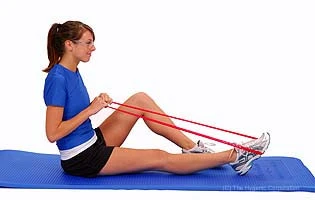
Standing heel raise
- Start with the standing position.
- Place your hand on the backrest of the chair for support.
- Breathe deeply.
- Next, lift your heels off the floor.
- Hold this position for a few seconds.
- Place your heels on the ground and take a deep breath.
- Then return to your neutral position.
- Then relax.
- Repeat these exercises five to ten times.

Seated Heel Raises
- Put your feet level on the floor and sit down at a stable table.
- After that, focus on your calf muscles.
- Put pressure on your foot.
- Raise your heels.
- Hold this position for a few seconds.
- Take your heels off the ground.
- Then return to your neutral position.
- Then relax.
- Repeat these exercises five to ten times.
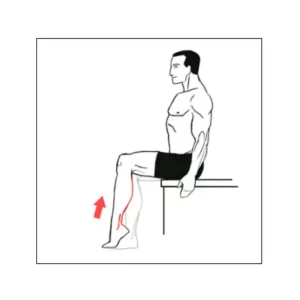
Standing Calf Raises
- Start with a standing position.
- Position a strong chair or other supporting object in front of you.
- To maintain balance, rest your hands comfortably on the chair’s back.
- With caution, raise both heels off the floor, using your calf muscles.
- To try a complete extension at the top, lift your heels as high as you can.
- Hold this position for a few seconds.
- At the highest point of the workout, squeeze your calf muscles.
- Then return to your neutral position.
- Then relax.
- Repeat these exercises five to ten times.

Towel stretch
- Sit down on the floor to start. After that, extend your leg.
- Holding the towel with both hands, put it over one foot.
- Stretching your calf begins with slowly drawing your toes into your shin.
- Hold this position for a few seconds.
- Then return to your neutral position.
- Then relax.
- Repeat these exercises five to ten times.
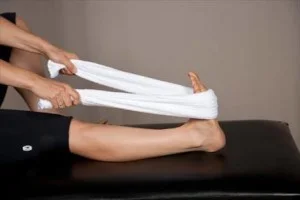
Lunges
- Start with the standing position.
- A step longer than a walking step is necessary for progress.
- After that, place one leg in front of you.
- Behind it, the other foot is in this posture.
- Your foot should make flat contact with the ground and remain there.
- Your rear heel will be raised off the ground.
- After that, lower your knees to a 90-degree angle.
- Hold this position for a few seconds.
- Then return to your neutral position.
- Then relax.
- Repeat these exercises five to ten times.

Toes on the Wall Stretch
- Place your toes onto the wall and face it.
- The stretch deepens as you raise your toes.
- As you move, make sure your heel stays firmly planted on the floor.
- The second leg should be behind you.
- Put your heel down.
- Keep your toes forward.
- Hold this position for a few seconds.
- Then return to your neutral position.
- Then relax.
- Repeat these exercises five to ten times.
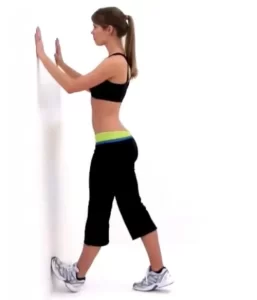
Single-leg balance
- Proceed by standing on the ground.
- You ought to have your arms close at hand.
- One leg can be bent at the knee, and the foot can be pushed back.
- Stand up and use your other foot to balance.
- Hold this position for a few seconds.
- Drop the elevated foot.
- Then return to your neutral position.
- Then relax.
- Repeat these exercises five to ten times.
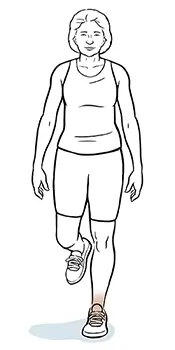
Eccentric Heel Drops
- On a stairway or other elevated surface, place your heels over the edge.
- During this stage, you can hold onto the wall or railing for balance.
- Get up on your toes to begin.
- During this stage, you can hold onto the wall or railing for balance.
- As you carefully lower your heels below the step level, maintain control of the movement.
- Make sure to take your time during this eccentric (lowering) phase for the best results.
- Use both legs to lift yourself back up to the beginning position after lowering your heel as far as is comfortable.
- Then return to your neutral position.
- Then relax.
- Repeat these exercises five to ten times.
What precautions must be taken when working out?
Exercises for rehabilitation are essential, but time, skill, and intensity are necessary. Ignoring important phases or doing too much too soon may worsen the tear.
Warm Up Correctly
- Engage in mild range-of-motion activities.
- A cold muscle should never be stretched.
Exercise on Safe Surfaces
- Workout on non-slip, flat, and clean surfaces.
- Use a mat or towel for exercises that require you to sit or lie down.
Early on, stay away from high-impact activities.
- No jumping, running, or sudden shifts of direction.
- Until a doctor gives the all-clear, stay away from sports and strenuous leg exercises.
Proceed Gradually
- Depending on pain and tolerance, progressively increase the length, complexity, and intensity.
Make Use of Supportive Equipment
- For extra support during workouts, use tape or compression sleeves.
Pay Attention to Your Body
- There should be no pain during or after the activity, but some soreness is ok.
Use the Proper Approach
- It is important to complete each exercise slowly and thoroughly.
- Use a mirror or get a therapist to go over your form.
Be sure you get sufficient rest and drink plenty of water.
- To help in the repair and reconstruction of muscles, get enough sleep.
- Stay hydrated.
When did you stop exercising?
Sudden or Severe Pain
- Even while mild to moderate pain is normal, severe, stabbing, or worsening pain indicates that the joint is being overstressed.
Walking difficulties, bruises, or swelling
- If there is any noticeable discolouration, swelling, or limping, stop.
- Continuing could make the injury worse or take longer to heal.
Strength or range of motion loss during exercise.
- A sudden weakness or stiffness in your foot or ankle could be a sign of a strain or re-injury.
- You should take a moment to reflect with your physical therapist.
A sensation of tingling or numbness
- Reduced blood flow or nerve involvement could result from this, both of which require medical attention.
Persistent Pain After Exercise
- If you have soreness, stiffness, or swelling after a session that lasts more than a day or two, you’ve most likely overexerted yourself.
- Reduce the amount of intensity or return to a safer situation.
Fatigue or Capable of Losing Control
- If your leg muscles are too tired to maintain proper technique or posture, stop and take a break.
- Holding this posture raises the possibility of harm and bad form.
What steps can I take to avoid tearing my calf muscles?
It takes a combination of stretching, strengthening, and effective training practices to prevent a calf muscle injury.
The following are important strategies:
Get Well Warmed Up
- Always begin with five to ten minutes of mild aerobic exercise, such as moderate cycling or walking.
- Dynamic stretches like high knees, ankle circles, and leg swings should come next.
Build Up Your Calf and Supporting Muscles
- Increase the strength and endurance of your calves and the surrounding muscles (hamstrings, glutes).
Pay Attention to Your Body and Pain
- During extended training sessions, take rests.
- If necessary, apply compression, foam rolling, or massage.
Training Progresses Gradually
- Try not to overstress your calves by rapidly raising the volume or intensity.
- Schedule days for rest and recuperation.
- After long sessions, always give yourself time to recover.
Put on Proper Footwear
- Poor footwear might change your walking patterns and stress your calf muscles.
- For runners in particular, replace your shoes every 500–800 kilometers.
Drink plenty of water and eat healthily.
- Muscle tearing and spasming are more likely in dehydrated muscles.
- Ensure your diet includes sufficient amounts of calcium, magnesium, and potassium.
After each workout, cool down.
- Lowering body temperature reduces pain after exercise and aids in lactic acid elimination.
- Five minutes of light walking
- Stretching gently, especially the hamstrings and calves
Include Recovery Tools and Massage
- To increase blood flow, use compression sleeves.
- After intense sessions, use cold therapy to reduce inflammation.
Summary:
A calf muscle tear could affect movement, making walking challenging. Pulling the calf muscle is a common injury, particularly when doing challenging or new exercises.
Numerous symptoms could indicate a torn calf muscle, depending on the extent of the injury. Soreness following an exercise session may resemble pain from modest muscular strain. A serious injury can cause immediate, intense pain that prevents or makes walking extremely difficult until the muscle heals.
Most of the time, a torn calf muscle may be treated at home with rest, cold and hot packs, compression, and elevation. Over-the-counter pain relievers might also assist.
It is important to contact a doctor for diagnosis and treatment if the injury is serious or if the pain does not go away with time.
FAQ:
What is a calf muscle tear?
A calf muscle tear happens when the muscular fibers at the rear of the lower leg, typically in the gastrocnemius or soleus muscles, rupture partially or completely.
After a calf muscle tear, when can I resume exercising?
After the initial inflammation has gone down, which usually happens two to five days following the incident, you should start doing mild rehabilitation exercises. However, since the degree of the tear determines the timing, always follow the recommendations of your physician or physical therapist.
Should I refrain from doing certain exercises?
Yes, stay away from:
Running, jumping, and other high-impact exercises until cleared
Early-stage aggressive stretching
Painful motions could worsen the injury.
What can I do in rehabilitation to avoid being hurt again?
Before beginning an activity, warm up.
Exercises should be progressed gradually.
Strengthen your calf muscles and the muscles that surround them (hamstrings, glutes).
Stay flexible
When may I resume my athletic activities or jogging?
The extent of the tear determines this.
Generally speaking:
Mild Grade I: 1-2 weeks
Moderate Grade II: three to six weeks
Grade III Severe: two to three months or longer
Always make a slow and careful return.
Do I need to visit a physical therapist?
Especially for mild to severe tears. By leading you through safe, progressive exercises tailored to your healing phase, a physical therapist can help you prevent re-injury.
What leads to a tear in the calf muscle?
Typical reasons include:
A sudden shift in direction or speed
Excessive stretching
Activities involving jumping or running
Poor warm-up or muscle fatigue
Can someone with a torn calf muscle walk?
The severity affects this. While moderate to severe tears could need the use of crutches or a walking boot, mild tears might permit limited movement.
When should I visit a physician?
Seek medical help if you suffer from:
Extreme pain or edema,
Unable to support weight, Bruising, or deformity. After a few days of rest, nothing changed.
When a calf tear occurs, is surgery necessary?
Surgery is usually reserved for the following reasons and is rarely required:
Total ruptures of the muscles
Conservative treatment was unsuccessful.
Professional sports participants
Which complications are frequently encountered?
Among the potential issues are:
Re-injury
Weakness or stiffness in the muscles
Formation of scar tissue
Persistent pain in the calves
How quickly can a torn calf muscle be healed?
The majority of torn calf muscles are treatable at home:
Give your damaged leg some rest. For one or two days, relax. Apply ice.
References:
- Taylor, R. B. (January 2, 2025). The best calf muscle strengthening exercises. WebMD. www.webmd.com/fitness-exercise/calf-muscle-strengthening
- Physio, S. (a). n.d. The Top 5 Calf Strain Exercises Suggested by Surrey Physio. The Surrey Physio. https://www.surreyphysio.co.uk/top-5/ideal-5-calf-strain-exercises/
- May 23, 2023; Eske, J. How a pulled calf muscle is treated, diagnosed, and healed. Medical News Today: https://www.medicalnewstoday.com/articles/326431
- Fracture Clinic Virtual. (2021). The file Ankle-011-Calf-Muscle-Tear.pdf may be found at https://www.dchft.nhs.uk/wp-content/uploads/2021/07.
- On March 11, 2024, Ocs, T. P. D. A strained calf can be healed in eight different ways. Tim and I Have PT Time. These exercises are for calf strains: https://pttimewithtim.com/
- Calf muscle tear. June 2, 2025. Cleveland Clinic. 21696-torn-calf-muscle https://my.clevelandclinic.org/health/diseases
- Admag. January 5, 2025. Stretching exercises for an efficient recovery from calf strains | Rosanna Physio. https://rosannaphysio.com.au/effective-calf-strain-recovery-stretching-exercises-for-pulled-calf-muscle/ Rosanna Physio
- February 27, 2024, Village Gym. An overview of the most effective exercises for post-injury calves. This is a guide to the best calf-strengthening exercises to do after an injury: https://www.villagegym.co.uk/blog/
- Bailey, A., and Images, K. (February 24, 2020). Calf muscle tear exercises. www.livestrong.com. Here are some exercises for a torn calf muscle: https://www.livestrong.com/article/368337
